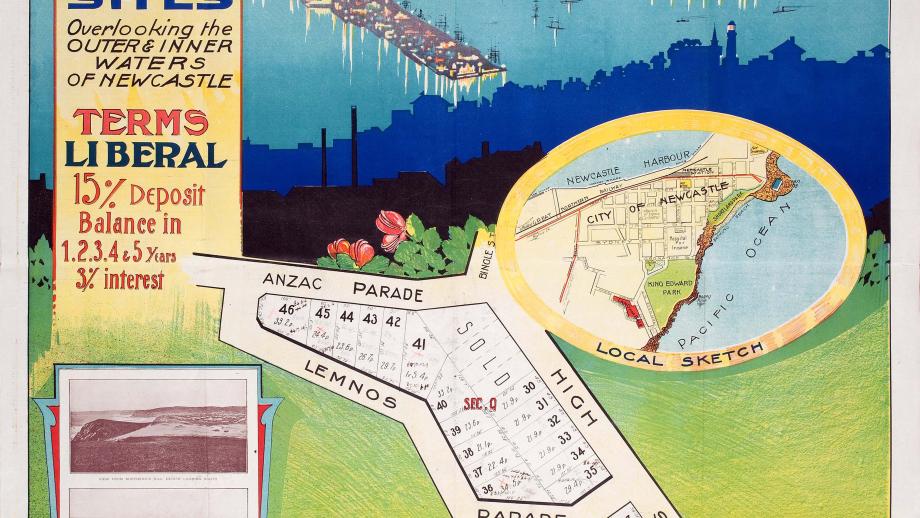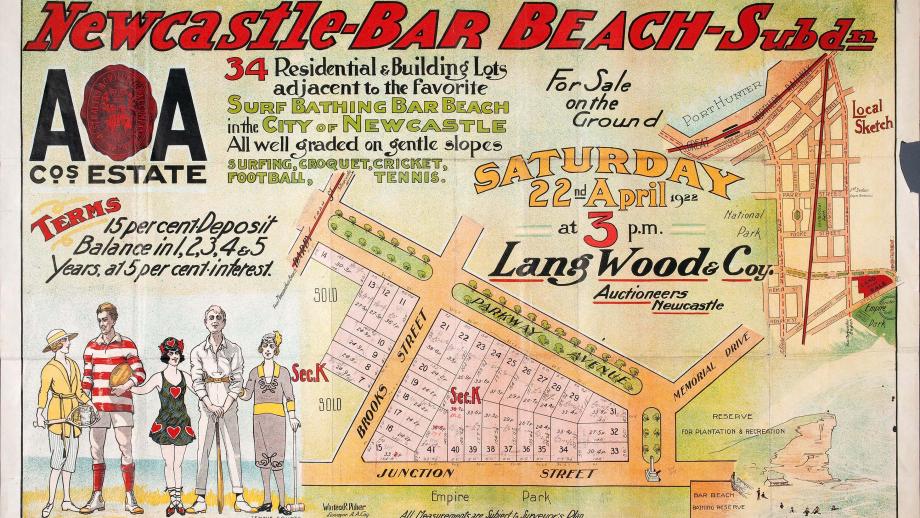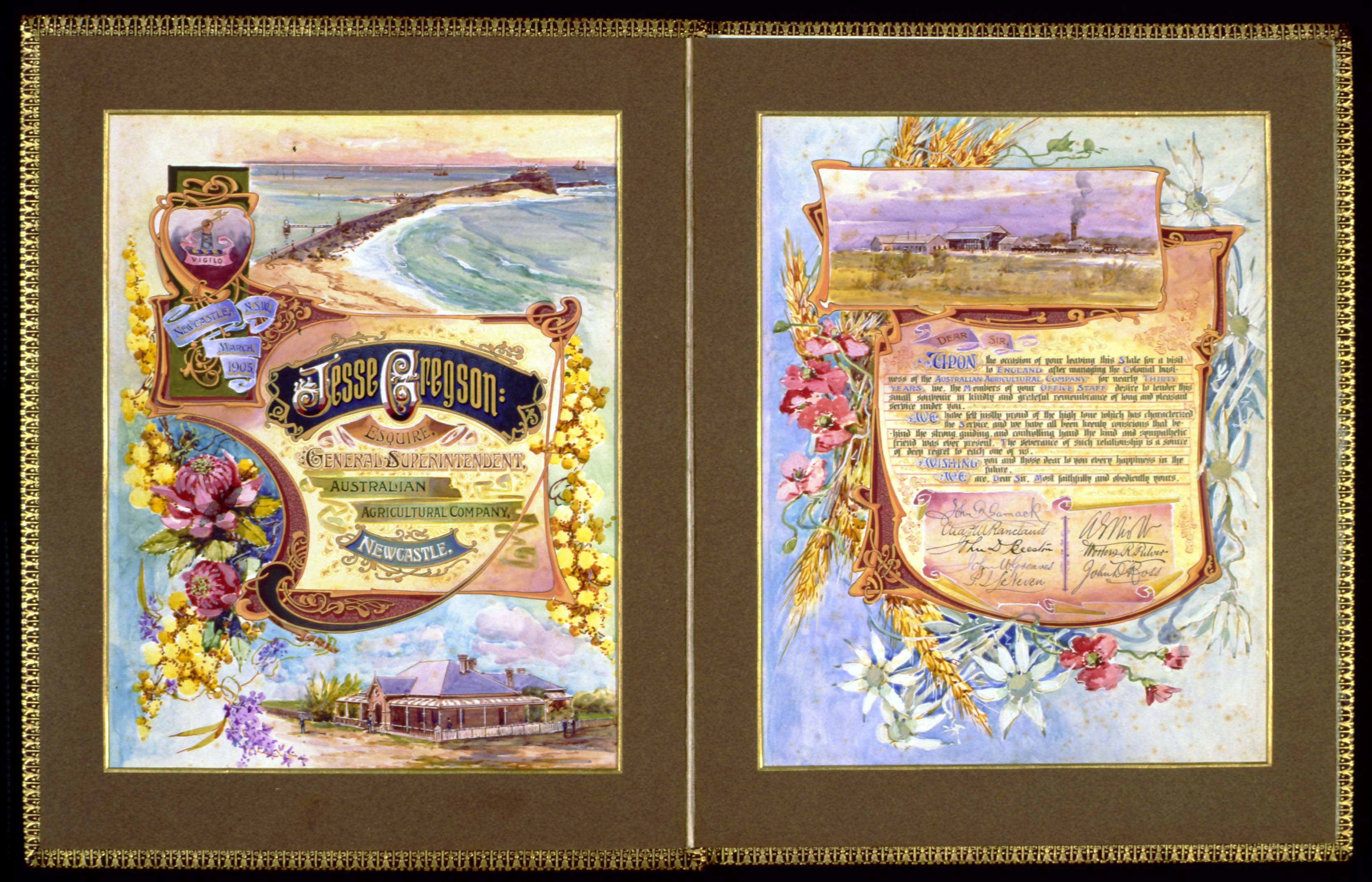Australian Agricultural Company
Australian Agricultural Company
The Australian Agricultural Company (AACo) The Australian Agricultural Company (AACo) was formed in London in April 1824. Its purpose was to raise fine woolled sheep and sell wool on the London market. Its directors and major shareholders included directors of the Bank of England, the East India Company and Members of Parliament; with assigned convicts given the roles of shepherding and general labour.
The Company’s initial land grant was one million acres in New South Wales, divided into three blocks: 464,640 acres between Port Stephens and the Manning River (Port Stephens Estate), 249,600 acres on the Liverpool Plains west of Willow Tree (Warrah) and 313,298 acres at the Peel River near Tamworth (Goonoo Goonoo). The AACo operated in four major NSW locations during the 19th century – Port Stephens, Tamworth, Quirindi, and Newcastle, before also acquiring land in Queensland and Northern Australia. Its interests expanded to include wool, wheat, cattle, coal and land sales.
In its first year of operation the AACo became involved in coal mining at Newcastle, with the first pit opened in 1831. The discovery of gold on the Company’s Peel Estate led to the formation of the Peel River Land and Mineral Company in 1854. Between 1825 and 1862 the AACo brought from Europe to New South Wales over 700 men to work either at the colliery in Newcastle or pastoral estates at Port Stephens, Tamworth and the Liverpool Plains. The new arrivals were managers, skilled mechanics, shepherds, miners and labourers.
In 1864 the AACo began the development of the Warrah Estate for sheep breeding, investing extensively in wells, bores and fencing. The AACo purchased Corona (near Longreach) in 1912; Bladensburg (near Winton) and Highfields (between Corona and Bladensburg) in 1915; Headingly (Urandangie) in 1916; before moving into the Northern Territory with the purchased of Avon Downs (Barkly Tablelands) in 1921. From the 1930s AACo became increasingly involved in beef cattle, developing the Santa Gertrudis stud at Goonoo Goonoo and purchasing Rockhampton Downs (Barkley Tablelands NT) in 1948, Wrotham Park (near Chillagoe, Q) in 1963, Brunette Downs (north of Tennant Creek) in 1979.
In 1975 the London-based directors resigned and the Company’s tax domicile was transferred from London to Tamworth and then Brisbane in 1985 following the sale of Goonoo Goonoo. From 1976 the Company’s name was listed on the Australian Stock Exchange as the Australian Agricultural Company Limited. In 1995 Elders Ltd acquired the AACo and it was delisted from the Australian Stock Exchange. The Company became a wholly owned subsidiary of Futuris Corporation Limited after Futuris took over Elders in 1997. The Company was re-listed in 2001.
We are fortunate to hold extensive collections of AACo records including all types of company records and records relating to their land holdings. This includes a large number of land sale and auction posters for subdivisions in a number of Newcastle suburbs and surrounding areas such as Cessnock and Lake Macquarie, dating from the 1890s to 1930s.
Australian Agricultural Company – Illuminated address presented to Jesse Gregson
Jesse Gregson was born in 1837 in Kent, England and was commenced work with his solicitor father at the age of 15. Uninterested in the law and unsettled by his mother's death in 1852 and his father's remarriage he left for Sydney in 1856 and arrived with £50 in gold and letters of introduction.
Unable to find work in Sydney, Gregson accepted the invitation of fellow passenger Alexander Busby to visit him at Llangollen station near Cassilis. He found work at Collaroy, a nearby station, where he learnt stock management, helped with the lambing and in 1858 became head overseer at. In May 1860, as Busby's partner, he overlanded 5000 ewes to a new station, Rainsworth, in Queensland. He entered a new partnership of seven years and celebrated it by investigating the use of wire fencing in Victoria. He soon fenced 20,000 acres, the first to use wire fencing in the district.
In 1870 Gregson accompanied Busby, who had been elected to the board of the Australian Agricultural Co., on a visit to Warrah, the company's station on the Liverpool Plains. Four years later Busby recommended him as superintendent of the company, a position he held from 1875 to 1905. In this role he had charge of one of the most important enterprises in Australia and applied himself with vigour to the care of the company's extensive pastoral and mining properties. He rebuilt the company’s sheep flock at Warrah following a severe drought in 1877-78 which killed 25,000 sheep died in a severe drought, a disaster which made Gregson doubt the value of pastoral investment, but by 1880 Warrah had 113,000 sheep (by 1880 there were 113,000 sheep at Warrah). He responded to increases in the value of company land following railway extensions, culminating in the disposal of the Port Stephens estate in 1893. With Nelson Brothers he built a chilling and freezing works at Aberdeen.
Gregson mastered the coal-mining industry and became a spokesman for colliery proprietors. In his dealings with the miners' union Gregson was both just and hard. He believed that it was wrong for miners employed by different companies to make common cause in a single union, and notably in 1882 he attempted several times to split the union by cutting the hewing rate and precipitating a strike. His aim was a union restricted to employees of his company and his policy was opposed to the essential principle of unionism.
In the 1880s Gregson took the lead in preparing employers for conflict with workers. In the maritime strike he joined the intercolonial conference of employers and in 1890-91 he served on the royal commission on strikes. He was also appointed to the royal commission which prepared the case for the Coal Mines Regulation Act, 1896.
Much of Gregson’s family life was spent in the Blue Mountains, where he pursued his great interest in botany, sending specimens to the Botanic Gardens which are still preserved at the National Herbarium. He died at the age of 82 in 1919, with most of his £17,500 estate left to his surviving children.
Australian Agricultural Company – Recruitment posters
Being such a large employer of young men during the First World War, the Australian Agricultural Company, like many other Australian companies, assisted the war effort by attempting to recruit its employees for the AIF. This included using recruitment posters to motivate employees to join up, particularly from 1915 onwards, when the initial recruitment drive was waning and more men were needed.
Many of the recruitment posters used in Australia were produced in England, but from 1915 onwards, the Australian Government started to produce posters locally.















